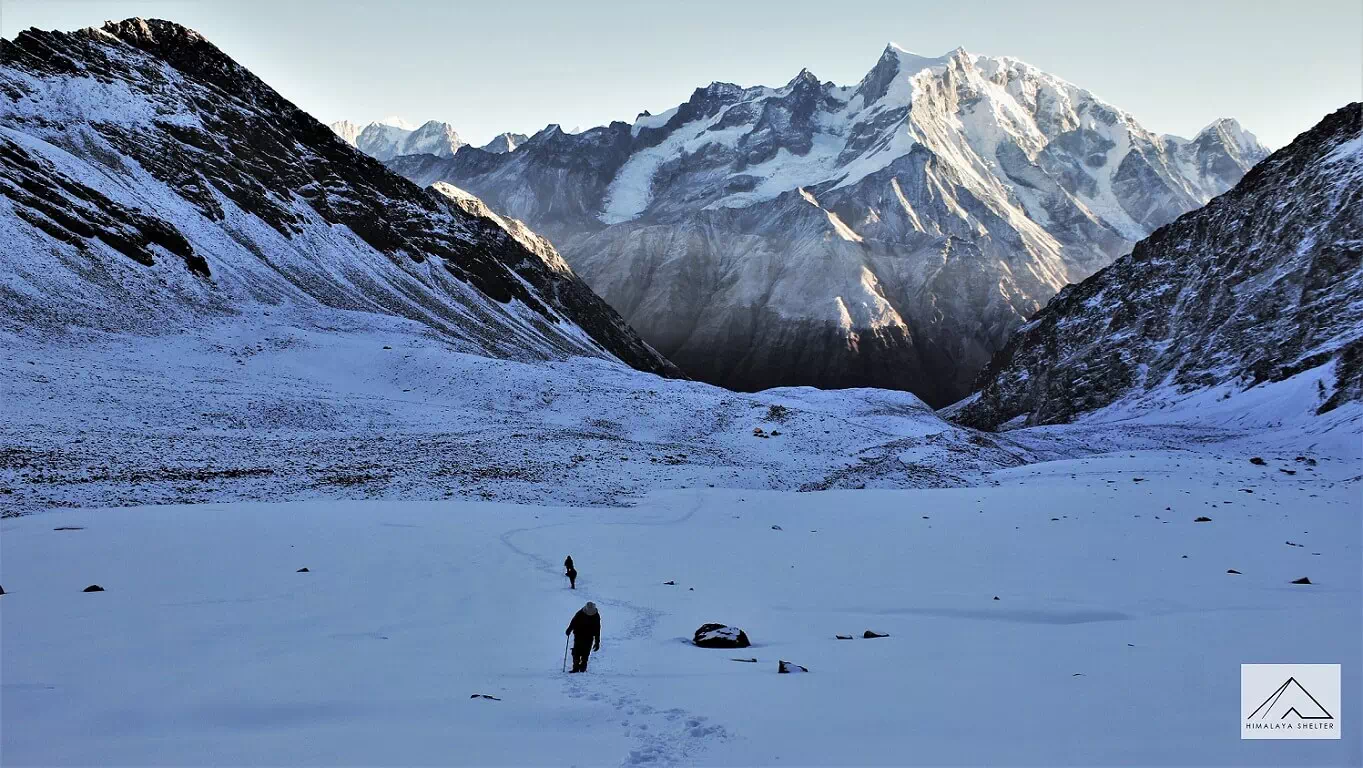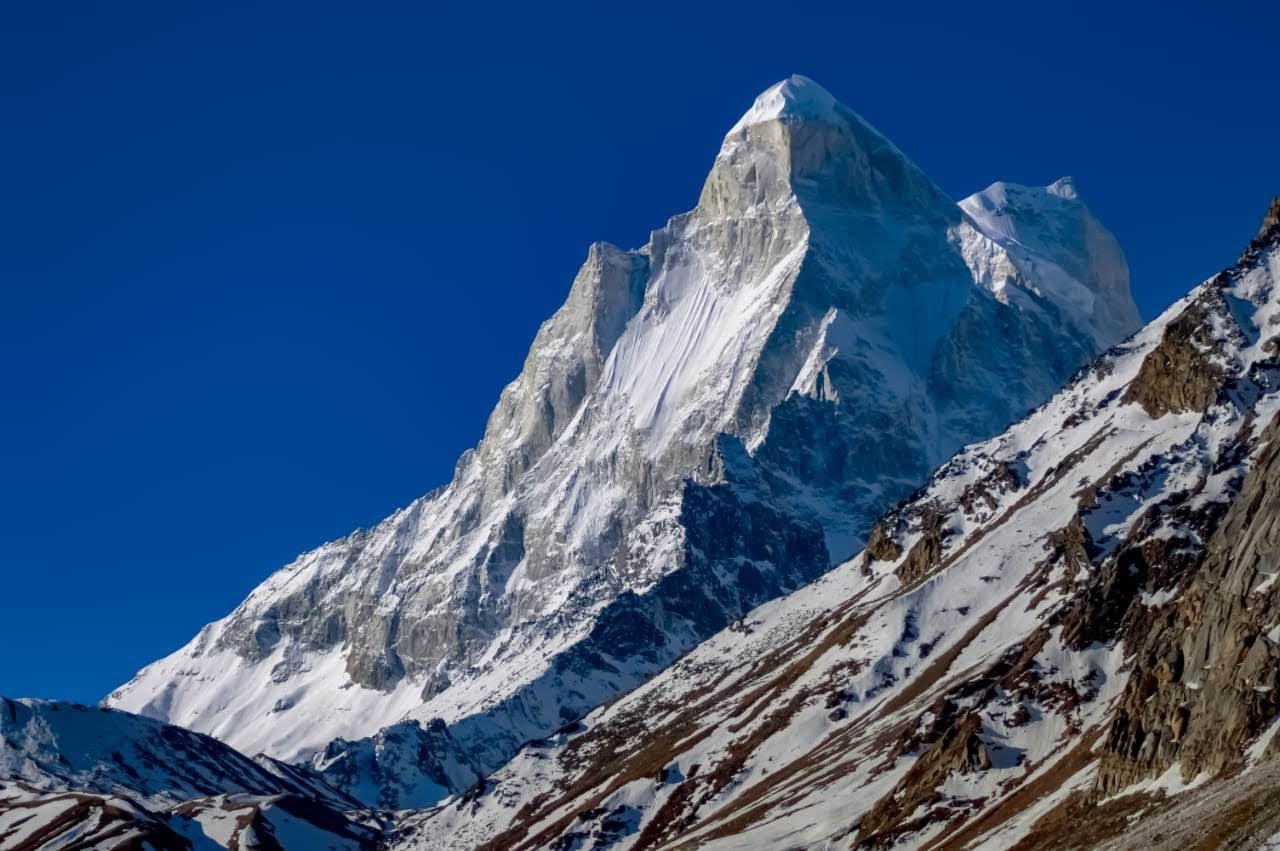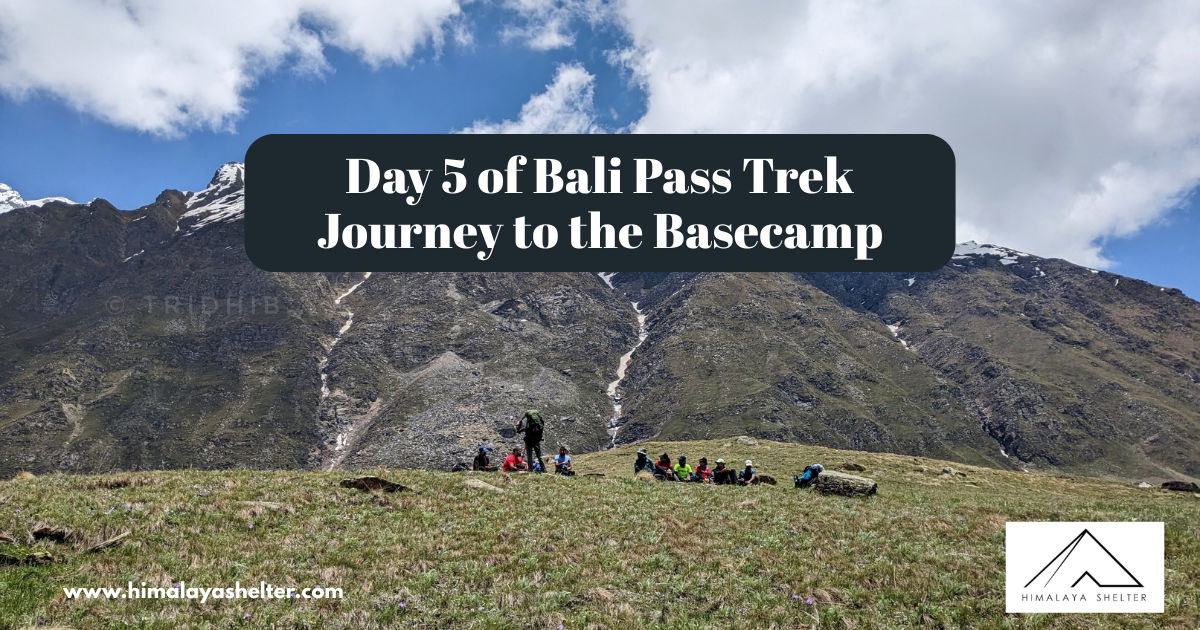The path crosses over a few streams which merge with Supin. After a few hours of walk the village of Gangad can be seen towards the left, across the river. We continue our trek and after about an hour′s walk, the quaint village of Osla unfolds itself. Seema is a tiny settlement opposite to the river from Osla. We set camp here or stay in a hut with a local family in the village.

Har Ki Dun Bali Pass
TREK DIFFICULTY
Difficult
TREK DURATION
11 Days
HIGHEST ALTITUDE
16,076 ft
GROUP SIZE
12
TREK DISTANCE
66 km
BASECAMP
Har Ki Dun Bali Pass | Uttarakhand
BEST TIME
May to June and September to October
PICKUP POINT
Dehradun
Har Ki Dun Bali Pass Trek Overview
This trek combines the two respective treks to Har Ki Dun Valley and the Bali Pass crossover to Yamunotri. The trek can be completed in 10 to 11 Days. The trek starts from Sankri and after a drive of 10 KM to Taluka we start walking towards the Har Ki Dun valley. We can visit attractions like the beautiful villages of the Har ki Dun Valley, namely Gangaad, and Osla, and proceed to the valley and its attractions. Marinda Tal Lake or Hata Valley ahead of Har Ki Dun are easy to reach. Experienced trekkers can even attempt to reach the Jaundhar Glacier situated right at the base of Swargarohini Massif. The trek is fairly challenging and requires us to cover significant distances and gain a maximum height of more than 16,000 feet (4,900 meters).
Day 1: Dehradun to Sankri - 190 KM drive in 8 hours
We start early from Dehradun and reach the village Sankri by evening. The final stretch is through the Govind Pashu National Park after we cross a check post at Netwar. We rest at night in a guest house.
Day 2: Sankri to Seema/Osla(2,700 m): 14 KM trek in 5 to 6 hours
Post breakfast we are transported from Sankri to Taluka. The drive is a bit bumpy. The trek commences from Taluka on a stony path. With the river Supin gushing through rapids beside us, under the shade of walnut, pine and other trees, the walk is quite pleasant. Often the passing villagers greet us on the way.
Day 3: Osla to Har ki Dun (3,510 m): 11 KM trek in 4 to 5 Hours
From Osla the trail gradually rises higher and passes through bushes of flowers like orchids, fleece flowers and sunflowers. The ascending path climbs high above the confluence of Supin river and the river from Ruinsara valley.
After traversing higher up along the left side of the river, we camp at a very panoramic spot in Har ki Dun, located at the junction of two valleys: one originating from Jaundhar glacier and the other from beyond Hata glacier.
Day 4: Explore Har ki Dun: 5 KM in 3 to 4 hours
We can choose to relax and soak in the environment or we have several trails as options.
The vast open meadows following the course of the Supin river can be explored. Further ahead of the meadows one can walk among the forests of Bhojpatra trees (Himalayan birch) or get a closer glimpse of the Jaundhar glacier and Swargarohini peak.
One can visit the Marinda Tal just 2km away from Har ki Dun. It is small glacial lake formed by a huge rock obstructing the river which flows down from Borasu pass.
The little-known valley of Hata can be explored which lies in between the above two valleys. It also has some large meadows and a close view of the Hata glacier and peak.
Day 5: Har ki Dun to Waterfall (3,330 m): 9 KM trek in 4 to 5 hours
In this day we initially follow the trail coming back from Har ki Dun to Osla. After about 1 km we follow a path downhill on our left which leads to a small bridge and cross over to the opposite side. The path is through a dense forest for about 2 km. Then it turns left and enters the Ruinsara valley. From here it takes about 2 hours to reach the camping ground near the waterfall.
Day 6: Waterfall to Ruinsara lake (3,600 m): 4 KM trek in 2 Hours
We ascend into the Ruinsara valley. There is a stark difference in the vegetation with pine and fir giving way to birch and rhododendron. Ruinsara lake is a lovely lake surrounded by meadows and rhododendron bushes. It is considered sacred by the locals. Since, the trek is short, we have sufficient time on this day to acclimatize and explore the trails nearby. Overnight in camps near the lake.
Day 7: Ruinsara lake to Thanga (3,810 m): 2 KM trek in 1 to 2 hours
We start the day early and can explroe the trail to Black Peak and Swargarohini basecamp before going towards our destination. We walk across the valley below Ruinsara lake and cross the river over a bridge. There is a steep ascent from the bridge to a ridge. The trail from here to the campsite passes through some beautiful meadows. We get a view of Swargarohini peak behind us from the campsite.The camp is set We camp below the pass along the glacial moraine. This is one of the best locations for a camp with the valley below and the pass behind you. Camping at this altitude is a new experience which very few treks offer.
Day 8: Thanga (3,810 m) to Bali Pass basecamp (4,400 m): 4 KM in 5 to 6 hours
From the camp we turn right and ascent towards the pass. The trails have boulders and rocks. After about 1.5 km, we walk on a narrow and ascending ridge which ends near our campsite. We camp below the pass along the glacial moraine. This is one of the best locations for a camp with the valley below and the pass behind you. Camping at this altitude is a new experience which very few treks offer.
Day 9: Bali Pass basecamp (4,400 m) to upper Dhamni (4,000 m) via Bali pass (4,900 m): 12 KM trek in 7 to 8 hours
We start very early, before sunrise on this. The steep climb to the pass commences just after a short walk. We reach the top of the pass by early morning. We get a gorgeous view of various peaks from here especially of the Banderpunch peaks on a clear day. From the pass, we descend down into the alpine zone and reach the camping grounds of upper Dhamni. This place has water nearby.
Day 10: Upper Dhamni to Yamunotri to Janki Chatti (2,400 m): 12 KM in 5 to 6 hours
You trek from Upper Dhamni to Yamunotri. Then you walk down to Janki Chatti. This is a very scenic pilgrim route. It goes through Himalayan forests.
You walk downhill in thick woods. You will cross streams and sunny spots. The trek ends at Yamunotri temple. Here you can take holy bath before mandir visit. You can hear the Yamuna River while praying
After visiting the temple, take the pilgrim path to Janki Chatti. This walk is about 5 to 6 km. It is an easy downhill section. You will see natural hot springs and small food stalls. The path is often busy with many trekkers and pilgrims. You will also see mules and carriers. Janki Chatti is at 2,400 meters. This busy town has simple eateries and guesthouses. It is a good place to stay the night.
Day 11: Janki Chatti to Dehradun: 180 KM drive in 7 to 8 Hours
The drive from Janki Chatti to Dehradun is about 180 kilometers. The roads are have curls and twisted. The trip takes seven or eight hours.
The route goes through Barkot. This is a busy town where people stop for tea or snacks. Then you drive toward Naugaon and Damta. The road between Janki Chatti and Barkot is narrow in places. It has sharp turns, so drivers must go slowly here.
After Barkot, the road gets wider and smoother. You will see deep valleys, thick forests, and small villages high up.
Traffic can be slow. This happens a lot during the Char Dham season when many pilgrims drive. Sometimes heavy rains cause road work or small landslides. It is safer to travel only during the day. Local drivers know the curves well. If you are new to driving in the mountains, watch out for quick stops and sharp turns.
Then you will reach to Dehradun. This city have good vibes and many best option to stay.
Inclusions
Our treks are specially designed by the experienced team at Himalaya Shelter, taking you on an adventure of a lifetime all while making you connect not only with the bountiful nature but also with yourself and with others on the trek with you creating wonderful memories which will last you a lifetime. All Himalaya Shelter treks are guided by experienced Trekkers having vast knowledge and experience of the region, providing with insightful information and stories pertaining to the region’s flora and fauna and the history of the region whilst the trek. It is safe to say that on successfully completing the trek, one will gain tremendous insight and experience along with lifetime memories.
- Transportation – Day 1: Driver from Dehradun to Sankri. Pickup time: 7:30 am, Prince Chowk, near Dehradun Railway Station
- Accommodation – At Base Camp, stay at a local homestay or guest house for one night each, which will give you an insight into the authentic lifestyle of the locals.( INR 5000 per person extra for single sharing throughout the trek )
On Trek stay in a 2-person Vango Halo Pro/A-Shape tent, which is to be shared by two trekkers, built to withstand extreme weather conditions and at the same time making you comfortable after a hard day’s trek. - Camping Equipment – specially designed sleeping bags that can withstand harsh weather conditions, foam mattresses. Other safety gear like microspikes, gaiters, an ice axe, and helmets will be provided.
- Medical Kit – our team will be equipped with an extensive medical kit, which our team is trained and experienced to use. Oxygen cylinders are used after they are thoroughly inspected throughout the Trek. Even campsites have large oxygen cylinders as backups.
- Permission - Forest entry charges for Indian nationals (Additional charges will be applicable for international tourists)
- Meals – Breakfast, packed lunch (on trek days), evening snacks, and dinner will be served. A hearty, delicious, and nutrition-filled Veg meals with egg preparation will be provided throughout the trek. (Jain and Vegan Food can also be arranged on prior notification.)There will be a dedicated Kitchen Tent along with a dining tent, which will have a dining table too.
- Our Team – A highly experienced and AMC-certified Trek Leader who will help ensure that the entire trek goes smoothly and safely while navigating the challenging conditions during the trek, and is skilled enough to navigate any medical emergency that can arise during the trek. Local and route Guides who are well-versed with the region and provide an in-depth insight into the local customs and knowledge of the flora and fauna endemic to the region. A dedicated Kitchen staff, which includes a Cook, a helper, and other support staff. There will also be porters and mules to carry common equipment.
- Cloakroom - We have a cloakroom facility available for extra luggage. Every trekker is permitted to leave their luggage behind at no charge.
Exclusions
- Personal expenses like tips, personal medicines, phone calls, etc.
- Travel Expenses - Travel expenses from your hometown to the mentioned Pick-Up Point are not included in the trek fee.
From the scheduled pick-up spot to the base camp, we have our own fleet of vehicles like Bolero, Innova, Dezire, or Tempo Traveler (12-seater). This is be shared by trekkers for a pre-decided amount. All vehicles are non-AC. - Personal Equipment - Any personal gear like jackets, shoes, cutlery, or backpacks is not included in the trek fee. We recommend renting them from our Rental Store for an affordable fee. This can be pre-arranged to avoid last-minute hang-ups.
- Offloading - We encourage carrying your backpack to get into the true spirit of trekking. However, if needed, you can opt to offload your personal luggage of up to 12 kgs for an additional cost of INR 350 per bag per day.
- Trek Insurance - A mandatory trek insurance fee is charged in addition to your trek fee. Since most medical insurance doesn’t cover adventure activities, trek insurance offers essential coverage, enhancing your safety without a significant financial burden.
Buffer day on the trek - We have kept a buffer day on the trek to account for any weather-related delay. If this is utilized, you will need to pay an extra amount to your trek leader. - Anything apart from inclusions
- Please carry a lunch box for a packed lunch/breakfast to avoid using polythene and Aluminium foil.
Keeping the Himalayas clean is our own responsibility. Reduce the use of Plastic when you are in the abode of the Sacred Himalaya. 🌱
Read More on Har Ki Dun Bali Pass
Photo Gallery












Treks by Categories
Treks By Month

Treks By Experience











































